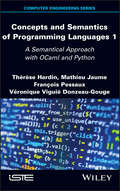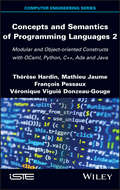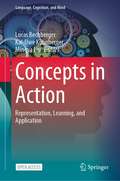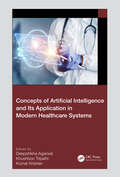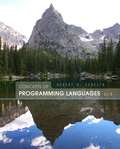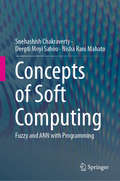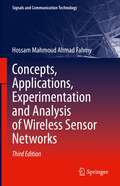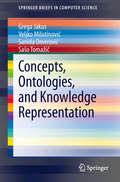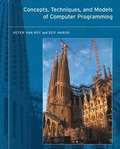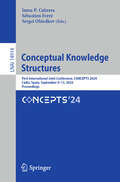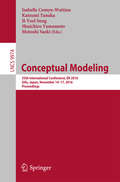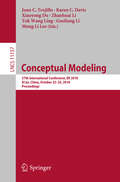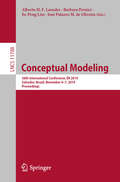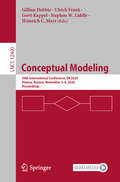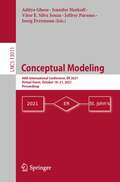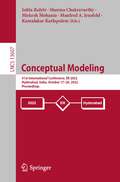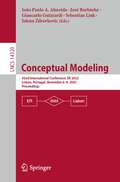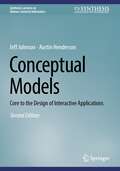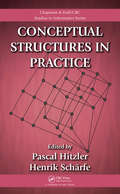- Table View
- List View
Concepts and Semantics of Programming Languages 1: A Semantical Approach with OCaml and Python
by Therese Hardin Mathieu Jaume Francois Pessaux Veronique Viguie Donzeau-GougeThis book – the first of two volumes – explores the syntactical constructs of the most common programming languages, and sheds a mathematical light on their semantics, while also providing an accurate presentation of the material aspects that interfere with coding. Concepts and Semantics of Programming Languages 1 is dedicated to functional and imperative features. Included is the formal study of the semantics of typing and execution; their acquisition is facilitated by implementation into OCaml and Python, as well as by worked examples. Data representation is considered in detail: endianness, pointers, memory management, union types and pattern-matching, etc., with examples in OCaml, C and C++. The second volume introduces a specific model for studying modular and object features and uses this model to present Ada and OCaml modules, and subsequently Java, C++, OCaml and Python classes and objects. This book is intended not only for computer science students and teachers but also seasoned programmers, who will find a guide to reading reference manuals and the foundations of program verification.
Concepts and Semantics of Programming Languages 2: Modular and Object-oriented Constructs with OCaml, Python, C++, Ada and Java
by Therese Hardin Mathieu Jaume Veronique Viguie Donzeau-Gouge François PessauxThis book – composed of two volumes – explores the syntactical constructs of the most common programming languages, and sheds a mathematical light on their semantics, providing also an accurate presentation of the material aspects that interfere with coding.Concepts and Semantics of Programming Languages 2 presents an original semantic model, collectively taking into account all of the constructs and operations of modules and classes: visibility, import, export, delayed definitions, parameterization by types and values, extensions, etc. The model serves for the study of Ada and OCaml modules, as well as C header files. It can be deployed to model object and class features, and is thus used to describe Java, C++, OCaml and Python classes.This book is intended not only for computer science students and teachers but also seasoned programmers, who will find a guide to reading reference manuals and the foundations of program verification.
Concepts in Action: Representation, Learning, and Application (Language, Cognition, and Mind #9)
by Lucas Bechberger Kai-Uwe Kühnberger Mingya LiuThis open access book is a timely contribution in presenting recent issues, approaches, and results that are not only central to the highly interdisciplinary field of concept research but also particularly important to newly emergent paradigms and challenges. The contributors present a unique, holistic picture for the understanding and use of concepts from a wide range of fields including cognitive science, linguistics, philosophy, psychology, artificial intelligence, and computer science. The chapters focus on three distinct points of view that lie at the core of concept research: representation, learning, and application. The contributions present a combination of theoretical, experimental, computational, and applied methods that appeal to students and researchers working in these fields.
Concepts in Smart Societies: Next-generation of Human Resources and Technologies
by Antonella Petrillo Chaudhery Mustansar Hussain Shahid Ul IslamWe live in a society driven by rapid and unpredictable changes. The concept of the “fourth industrial revolution” was introduced less than ten years ago - the more aware and reality oriented “smart factories”. By this we mean novelties in production technologies, enabling IT services and greater attention to energy consumption. Today, we are discussing the fifth stage in the evolution of society, the advent of the 5.0 company. This book outlines strategic lines and suggests future directions for the development of the "super smart society" which takes responsibility and ensures sustainability by adhering to new smart technologies and skills. The book is intended for a broad audience working in the fields of material science and engineering, energy, environment, etc. It is an invaluable reference source for researchers, academicians, students, industrial institutions, government and independent institutes, individual research groups and scientists working in the field of industrial applications of smart manufacturing design.
Concepts of Artificial Intelligence and its Application in Modern Healthcare Systems
by Deepshikha Agarwal Khushboo Tripathi Kumar KrishenThis reference text presents the usage of artificial intelligence in healthcare and discusses the challenges and solutions of using advanced techniques like wearable technologies and image processing in the sector. Features: Focuses on the use of artificial intelligence (AI) in healthcare with issues, applications, and prospects Presents the application of artificial intelligence in medical imaging, fractionalization of early lung tumour detection using a low intricacy approach, etc. Discusses an artificial intelligence perspective on wearable technology Analyses cardiac dynamics and assessment of arrhythmia by classifying heartbeat using electrocardiogram (ECG) Elaborates machine learning models for early diagnosis of depressive mental affliction This book serves as a reference for students and researchers analyzing healthcare data. It can also be used by graduate and post graduate students as an elective course.
Concepts of Programming Languages (Eleventh Edition)
by Robert W. SebestaFor courses in computer programming. Concepts of Computer Programming Languages introduces students to the fundamental concepts of computer programming languages and provides them with the tools necessary to evaluate contemporary and future languages. An in-depth discussion of programming language structures, such as syntax and lexical and syntactic analysis, also prepares readers to study compiler design. The Eleventh Edition maintains an up-to-date discussion on the topic with the removal of outdated languages such as Ada and Fortran. The addition of relevant new topics and examples such as reflection and exception handling in Python and Ruby add to the currency of the text. Through a critical analysis of design issues of various program languages, Concepts of Computer Programming Languages teaches programmers the essential differences between computing with specific languages.
Concepts of Soft Computing: Fuzzy and ANN with Programming
by Snehashish Chakraverty Deepti Moyi Sahoo Nisha Rani MahatoThis book discusses soft computing, which provides an efficient platform to deal with imprecision, uncertainty, vagueness and approximation in order to attain robustness and reliable computing. It explores two major concepts of soft computing: fuzzy set theory and neural networks, which relate to uncertainty handling and machine learning techniques respectively. Generally, fuzzy sets are considered as vague or uncertain sets having membership function lying between 0 and 1, and ANN is a type of artificial intelligence that attempts to imitate the way a human brain works by configuring specific applications, for instance pattern recognition or data classification, through learning processes.The book also presents C/MATLAB programming codes related to the basics of fuzzy set, interval arithmetic and ANN in a concise, practical and adaptable manner along, with simple examples and self-validation unsolved practice questions in few cases
Concepts, Applications, Experimentation and Analysis of Wireless Sensor Networks (Signals and Communication Technology)
by Hossam Mahmoud FahmyThe new edition of this popular book has been transformed into a hands-on textbook, focusing on the principles of wireless sensor networks (WSNs), their applications, their protocols and standards, and their analysis and test tools; a meticulous care has been accorded to the definitions and terminology. To make WSNs felt and seen, the adopted technologies as well as their manufacturers are presented in detail. In introductory computer networking books, chapters sequencing follows the bottom up or top down architecture of the seven layers protocol. This book starts some steps later, with chapters ordered based on a topic’s significance to the elaboration of wireless sensor networks (WSNs) concepts and issues. With such a depth, this book is intended for a wide audience, it is meant to be a helper and motivator, for both the senior undergraduates, postgraduates, researchers, and practitioners; concepts and WSNs related applications are laid out, research and practical issues are backed by appropriate literature, and new trends are put under focus. For senior undergraduate students, it familiarizes readers with conceptual foundations, applications, and practical project implementations. For graduate students and researchers, transport layer protocols and cross-layering protocols are presented and testbeds and simulators provide a must follow emphasis on the analysis methods and tools for WSNs. For practitioners, besides applications and deployment, the manufacturers and components of WSNs at several platforms and testbeds are fully explored.
Concepts, Applications, Experimentation and Analysis of Wireless Sensor Networks (Signals and Communication Technology)
by Hossam Mahmoud FahmyThe third edition of this hands-on textbook pursues the focus on the principles of wireless sensor networks (WSNs), their applications, their protocols and standards, and their analysis and test tools; a meticulous care has been accorded to the definitions and terminology. To make WSNs felt and seen, the adopted technologies as well as their manufacturers are presented in detail. In introductory computer networking books, chapters sequencing follows the bottom up or top down architecture of the seven layers protocol. This book is some more steps after, both horizontally and vertically, the view and understanding are getting clearer, chapters ordering is based on topics significance to the elaboration of wireless sensor networks (WSNs) concepts and issues.This book is intended for a wide audience, it is meant to be help and motivate, for both the senior undergraduates, postgraduates, researchers, and practitioners; concepts and WSNs related applications are laid out, research and practical issues are backed by appropriate literature, and new trends are put under focus. For senior undergraduate students, it familiarizes with conceptual foundations, applications and practical projects implementations. For graduate students and researchers, energy-efficient routing protocols, transport layer protocols and cross-layering protocols approach are presented. Testbeds and simulators provide a must follow emphasis on the analysis methods and tools for WSNs. For practitioners, besides applications and deployment, the manufacturers and components of WSNs at several platforms and testbeds are fully explored.
Concepts, Ontologies, and Knowledge Representation (SpringerBriefs in Computer Science)
by Veljko Milutinović Sanida Omerovic Grega Jakus Saso TomazicRecording knowledge in a common framework that would make it possible to seamlessly share global knowledge remains an important challenge for researchers. This brief examines several ideas about the representation of knowledge addressing this challenge. A widespread general agreement is followed that states uniform knowledge representation should be achievable by using ontologies populated with concepts. A separate chapter is dedicated to each of the three introduced topics, following a uniform outline: definition, organization, and use. This brief is intended for those who want to get to know the field of knowledge representation quickly, or would like to be up to date with current developments in the field. It is also useful for those dealing with implementation as examples of numerous operational systems are also given.
Concepts, Techniques, and Models of Computer Programming
by Peter Van-Roy Seif HaridiThis innovative text presents computer programming as a unified discipline in a way that is both practical and scientifically sound. The book focuses on techniques of lasting value and explains them precisely in terms of a simple abstract machine. The book presents all major programming paradigms in a uniform framework that shows their deep relationships and how and where to use them together. After an introduction to programming concepts, the book presents both well-known and lesser-known computation models ("programming paradigms"). Each model has its own set of techniques and each is included on the basis of its usefulness in practice. The general models include declarative programming, declarative concurrency, message-passing concurrency, explicit state, object-oriented programming, shared-state concurrency, and relational programming. Specialized models include graphical user interface programming, distributed programming, and constraint programming. Each model is based on its kernel language--a simple core language that consists of a small number of programmer- significant elements. The kernel languages are introduced progressively, adding concepts one by one, thus showing the deep relationships between different models. The kernel languages are defined precisely in terms of a simple abstract machine. Because a wide variety of languages and programming paradigms can be modeled by a small set of closely related kernel languages, this approach allows programmer and student to grasp the underlying unity of programming. The book has many program fragments and exercises, all of which can be run on the Mozart Programming System, an Open Source software package that features an interactive incremental development environment.
Conceptual Knowledge Structures: First International Joint Conference, CONCEPTS 2024, Cádiz, Spain, September 9–13, 2024, Proceedings (Lecture Notes in Computer Science #14914)
by Sébastien Ferré Sergei Obiedkov Inma P. CabreraThis book constitutes the proceedings of the First International Joint Conference on Conceptual Knowledge Structures, CONCEPTS 2024, which took place in Cádiz, Spain, during September 9-13, 2024. The conference is an amalgamation of the 18th International Conference on Formal Concept Analysis (ICFCA); the 17th International Conference on Concept Lattices and Their Applications (CLA); and the 28th International Conference on Conceptual Structures (ICCS). The 18 full and 4 short papers included in this book were carefully reviewed and selected from 38 submissions. They were organized in topical sections as follows: Theory; algorithms, methods, and resources; applications.
Conceptual Modeling: 34th International Conference, ER 2015, Stockholm, Sweden, October 19-22, 2015, Proceedings (Lecture Notes in Computer Science #9381)
by Paul Johannesson Mong Li Lee Stephen W. Liddle Andreas L. Opdahl Óscar Pastor LópezThis book constitutes the refereed proceedings of the 34th International Conference on Conceptual Modeling, ER 2015, held in Stockholm, Sweden, in October 2015. The 26 full and 19 short papers presented were carefully reviewed and selected from 131 submissions. The papers are organized in topical sections on business process and goal models, ontology-based models and ontology patterns, constraints, normalization, interoperability and integration, collaborative modeling, variability and uncertainty modeling, modeling and visualization of user generated content, schema discovery and evolution, process and text mining, domain-based modeling, data models and semantics, and applications of conceptual modeling.
Conceptual Modeling: 35th International Conference, ER 2016, Gifu, Japan, November 14-17, 2016, Proceedings (Lecture Notes in Computer Science #9974)
by Isabelle Comyn-Wattiau Katsumi Tanaka Il-Yeol Song Shuichiro Yamamoto Motoshi SaekiThis book constitutes the refereed proceedings of the 345h International Conference on Conceptual Modeling, ER 2016, held in Gifu, Japan, in November 2016. The 23 full and 18 short papers presented together with 3 keynotes were carefully reviewed and selected from 113 submissions. The papers are organized in topical sections on Analytics and Conceptual Modeling; Conceptual Modeling and Ontologies; Requirements Engineering; Advanced Conceptual Modeling; Semantic Annotations; Modeling and Executing Business Processes; Business Process Management and Modeling; Applications and Experiments of Conceptual Modeling; Schema Mapping; Conceptual Modeling Guidance; and Goal Modeling.
Conceptual Modeling: 37th International Conference, Er 2018, Xi'an, China, October 22-25, 2018, Proceedings (Lecture Notes in Computer Science #11157)
by Mong Li Lee Xiaoyong Du Juan C. Trujillo Karen C. Davis Zhanhuai Li Tok Wang Ling Guoliang LiThis book constitutes the refereed proceedings of the 37th International Conference on Conceptual Modeling, ER 2018, held in XI'an, China, in October 2018.The 30 full and 13 short papers presented together with 3 keynotes were carefully reviewed and selected from 151 submissions.This events covers a wide range of following topics: Conceptual modeling studies, ontological modeling, semi-structured data modeling, process modeling and management, spatio-temporal modeling, cloud-based modeling, schema and view modeling,languages and models, NoSQL modeling, conceptual modeling for machine learning and reasoning, applications of conceptual modeling.
Conceptual Modeling: 38th International Conference, ER 2019, Salvador, Brazil, November 4–7, 2019, Proceedings (Lecture Notes in Computer Science #11788)
by Ee-Peng Lim Barbara Pernici Alberto H. F. Laender José Palazzo M. de OliveiraThis book constitutes the refereed proceedings of the 38th International Conference on Conceptual Modeling, ER 2019, held in Salvador, Brazil, in November 2019.The 22 full and 22 short papers presented together with 4 keynotes were carefully reviewed and selected from 142 submissions. This events covers a wide range of topics, covered in the following sessions: conceptual modeling, big data technology I, process modeling and analysis, query approaches, big data technology II, domain specific models I, domain specific models II, decision making, complex systems modeling, model unification, big data technology III, and requirements modeling.
Conceptual Modeling: 39th International Conference, ER 2020, Vienna, Austria, November 3–6, 2020, Proceedings (Lecture Notes in Computer Science #12400)
by Heinrich C. Mayr Stephen W. Liddle Ulrich Frank Gerti Kappel Gillian DobbieThis book constitutes the refereed proceedings of the 39th International Conference on Conceptual Modeling, ER 2020, which was supposed to be held in Vienna, Austria, in November 2020, but the conference was held virtually due to the COVID-19 pandemic.The 28 full and 16 short papers were carefully reviewed and selected from 143 submissions. This events covers a wide range of topics, and the papers are organized in the following sessions: foundations of conceptual modeling; process mining and conceptual modeling; conceptual modeling of business rules and processes; modeling chatbots, narratives and natural language; ontology and conceptual modeling; applications of conceptual modeling; schema design, evolution, NoSQL; empirical studies of conceptual modeling; networks, graphs and conceptual modeling; and conceptual modeling of complex and data-rich systems.
Conceptual Modeling: 40th International Conference, ER 2021, Virtual Event, October 18–21, 2021, Proceedings (Lecture Notes in Computer Science #13011)
by Aditya Ghose Jeffrey Parsons Jennifer Horkoff Vítor E. Silva Souza Joerg EvermannThis book constitutes the refereed proceedings of the 40th International Conference on Conceptual Modeling, ER 2021, which will be held as virtual event, in October 2021. The 14 full and 18 short papers were carefully reviewed and selected from 85 submissions. The conference presents topics on conceptual modeling, its foundations and applications. Celebrating its 40th anniversary this year, the overall theme of ER 2021 is: Conceptual Modeling in an Age of Uncertainty.
Conceptual Modeling: 41st International Conference, ER 2022, Hyderabad, India, October 17–20, 2022, Proceedings (Lecture Notes in Computer Science #13607)
by Mukesh Mohania Jolita Ralyté Manfred A. Jeusfeld Kamalakar Karlapalem Sharma ChakravarthyThis book constitutes the refereed proceedings of the 41st International Conference on Conceptual Modeling, ER 2022, held in Hyderabad, India, in October 2022. The 19 full and 11 short papers were carefully reviewed and selected from 82 submissions. The papers are organzed in the following topical sections: foundations of conceptual modeling; ontologies and their applications; applications of conceptual modeling; data modeling and analysis; business process; quality and performance; security, privacy and risk management; goals and requirements.
Conceptual Modeling: 42nd International Conference, ER 2023, Lisbon, Portugal, November 6–9, 2023, Proceedings (Lecture Notes in Computer Science #14320)
by Sebastian Link Giancarlo Guizzardi Jelena Zdravkovic José Borbinha João Paulo A. AlmeidaThis book constitutes the refereed proceedings of the 42nd International Conference on Conceptual Modeling, ER 2023, held in Lisbon, Portugal, during November 6-9, 2023. The 21 full papers were carefully reviewed and selected from 121 submissions. Additionally, the book contains 4 keynote speeches and 3 tutorials, and one invited paper corresponding to one of the keynote speeches. The papers cover a broad spectrum of classical and modern topics on conceptual modeling, including research and practice in the theories of concepts and ontologies, techniques for transforming conceptual models into effective implementations, and methods and tools for developing and communicating conceptual models.
Conceptual Modeling: 43rd International Conference, ER 2024, Pittsburgh, PA, USA, October 28–31, 2024, Proceedings (Lecture Notes in Computer Science #15238)
by Hyoil Han Wolfgang Maass Hasan Yasar Nick MultariThis book constitutes the proceedings of the 43rd International Conference on Conceptual Modeling, ER 2024, which took place in Pittsburgh, PA, USA, during October 28-31, 2024. The 22 full papers presented in this volume were carefully reviewed and selected from 113 submissions. They are grouped into the following topics: process modeling; advanced modeling languages; ontological modeling; domain and goal modeling; language models and conceptual modeling; applications of conceptual modeling.
Conceptual Models: Core to the Design of Interactive Applications (Synthesis Lectures on Human-Centered Informatics)
by Jeff Johnson Austin HendersonThis book presents readers with an exploration of the concept of Conceptual Models and argues that they are core to achieving good design of interactive applications that are easy, effective, and enjoyable to use. The authors’ years of experience helping companies create interactive software applications revealed that interactive applications built without Conceptual Models generally result in fraught production processes and designs that are confusing and difficult to learn, remember, and use. Instead, the book shows that Conceptual Models can be a central link between the elements involved in the use of interactive applications: people’s tasks (domains), their plans for performing those tasks, the use of applications in the plans, the conceptual structure of applications, the presentation of the conceptual model (i.e., the user interface), the terms used to describe it, its implementation, and the learning that people must do to use the application. Readers will learn how putting a Conceptual Model at the core of the design and development process can pay rich dividends: designs are simpler, more coherent, and better aligned with users’ tasks; unnecessary features are avoided; documentation is easier, development is faster and cheaper; customer uptake is improved; and the need for training and customer support is reduced. To support its use in instruction, this second edition has been revised to explain the history and theoretical context of conceptual modeling using a consistent vocabulary, describe the structure of conceptual models, provide more current and more complete examples, explain how conceptual models fit into design and development, and further summarize the benefits of conceptual modeling.
Conceptual Spaces: Elaborations and Applications (Synthese Library #405)
by Peter Gärdenfors Frank Zenker Mauri Kaipainen Antti HautamäkiThis edited book focuses on concepts and their applications using the theory of conceptual spaces, one of today’s most central tracks of cognitive science discourse. It features 15 papers based on topics presented at the Conceptual Spaces @ Work 2016 conference. The contributors interweave both theory and applications in their papers. Among the first mentioned are studies on metatheories, logical and systemic implications of the theory, as well as relations between concepts and language. Examples of the latter include explanatory models of paradigm shifts and evolution in science as well as dilemmas and issues of health, ethics, and education. The theory of conceptual spaces overcomes many translational issues between academic theoretization and practical applications. The paradigm is mainly associated with structural explanations, such as categorization and meronomy. However, the community has also been relating it to relations, functions, and systems. The book presents work that provides a geometric model for the representation of human conceptual knowledge that bridges the symbolic and the sub-conceptual levels of representation. The model has already proven to have a broad range of applicability beyond cognitive science and even across a number of disciplines related to concepts and representation.
Conceptual Structures in Practice (Chapman & Hall/CRC Studies in Informatics Series)
by Pascal Hitzler Henrik SchärfeExploring fundamental research questions, Conceptual Structures in Practice takes you through the basic yet nontrivial task of establishing conceptual relations as the foundation for research in knowledge representation and knowledge mining. It includes contributions from leading researchers in both the conceptual graph and formal concept analysis
